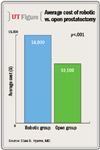Article
Robotic radical prostatectomy remains more costly than open technique
Author(s):
A robot-assisted laparoscopic radical prostatectomy costs 40% more than a retropubic radical prostatectomy, according to a review of hospital data from one state.

Key Points
Atlanta-A robot-assisted laparoscopic radical prostatectomy costs 40% more than a retropubic radical prostatectomy, according to a review of hospital data from one state.
"High surgical volume was associated with lower cost of radical prostatectomy," said first author Elias S. Hyams, MD, a former endourology fellow at Johns Hopkins University in Baltimore, working with Brian R. Matlaga, MD, MPH, and colleagues. "However, even at high surgical volume centers, the cost of robotic prostatectomy exceeded that of open prostatectomy.
"As robotic surgery has come to dominate the health care marketplace, strategies to increase the role of high-volume providers may be needed to improve the cost-effectiveness of prostate cancer surgical therapy," added Dr. Hyams, who is now at Dartmouth-Hitchcock Medical Center, Lebanon, NH.

Total costs comprised several components, including operating room costs, room and board, radiology, pharmaceuticals, laboratory, supplies, and miscellaneous therapies.
For their analysis, the authors defined high-volume hospitals as facilities that had an annual prostatectomy volume >60 cases. High-volume surgeons were those who performed >40 prostatectomies annually.
The analysis included 1,499 men who underwent robotic and 2,565 men who had retropubic prostatectomy between 2008 and 2011. The two groups did not differ significantly with respect to age, race, patient complexity level, or proportion of Medicare/Medicaid patients.
The robotic procedure was associated with a significantly shorter length of stay (1.7 vs. 1.9 days, p<.001), but the proportion of patients requiring a stay in the intensive care unit did not differ (1.3% amd 1.6% with robotic and retropubic RP, respectively).
In the robotic surgery group, 50.6% of procedures were performed by high-volume surgeons. In contrast, high-volume surgeons performed 70.2% of retropubic RPs (p<.001). Retropubic RPs also were performed more often at high-volume hospitals (83.3% vs. 74.8%, p<.001).
Costs driven by OR, supply charges
During the study period, the cost of a robotic prostatectomy averaged $14,000 compared with $10,100 for retropubic (p<.001). The difference was driven primarily by higher operating room and supply charges. A significant difference persisted even among high-volume hospitals (p<.001), said Dr. Hyams.
Both high-volume surgeons and high-volume hospitals were associated with a lower overall cost for retropubic surgery (p<.001). High surgeon volume was associated with a lower cost of robotic and retropubic RP (p<.001), whereas high hospital volume was associated with a lower cost for robotic RP only (p<.001).
During the discussion that followed his presentation, Dr. Hyams acknowledged that lack of information about the reported charges and true costs of the procedures was an inherent limitation of the database.
"It's a proxy for true costs, but it captures a very large percentage of the data within the state, so we're trading some granular detail for statistical power," he said.
The estimates did not take into consideration the capital costs associated with requiring robotic surgery systems, which would have resulted in even larger differences between the two types of procedures, Dr. Hyams told Urology Times.
"Those capital costs are sizable, on the order of a couple of million dollars, but it is difficult to estimate the per-procedure premium that robotic technology adds to the total cost of a radical prostatectomy," he said.
Newsletter
Stay current with the latest urology news and practice-changing insights — sign up now for the essential updates every urologist needs.















